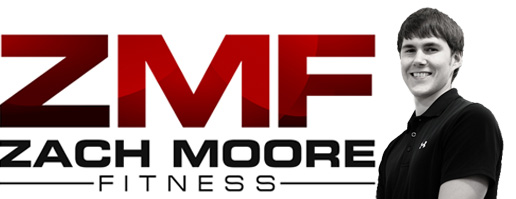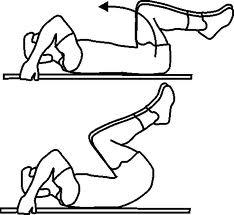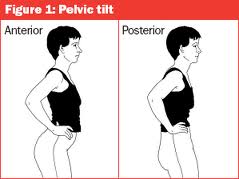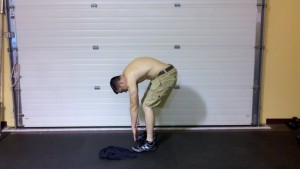Because of my recent posts on anterior pelvic tilt and how to effectively recruit your abs, I have been getting more and more questions from people wanting to know how they can get out of extension during exercises and/or daily life.
Here is a recent question I received from Robert:
“I have specific question regarding turning on obliques to prevent anterior pelvic tilt or/and rib flare I do know that this is somewhat connected but I am curious if you are proponent/endorse exercises sch as hanging leg rise, reverse crunch… as viable exercises to return the pelvis to normal/neutral position. If not which exercise do you use.”Unfortunately, the answer is not as simple as do this and do that. The only way I can tell you what to do would be to assess you, but since I can’t do that for everyone I am going to share some thoughts on possible solutions if you have a significant rib flare and/or are stuck in low back extension and an anterior pelvic tilt.
A lot of the writing below actually comes from a post over a year ago on my old site. However, some things have changed as my ideas have slightly evolved since then. Hope you enjoy.
Eric Cressey wrote an interesting post a while back titled, “Down on Lumbar Flexion in Strength Training Programs? Enter The Reverse Crunch.” In it, he explains why he is okay with going into, and training, some lumbar flexion (I want to make it clear that this was written over two years ago so Eric may have changed his views since then). His point was that a large percentage of the population is stuck in an anterior tilt with an exaggerated lumbar curve (overly extended).
Therefore, when these people perform a reverse crunch properly, they are flexing their lumbar spine, but not to end-range. They are flexing from a hyperlordotic position to a more neutral position. The purpose of the exercise for these people is to strengthen the muscles that will help posteriorly tilt their pelvis (such as the external obliques) and put them into a good lower back position.
While I mostly agree with Eric’s post, I do want to discuss why giving people a reverse crunch to help correct their overly lordotic low back position may not always be a good idea. The reason is because some people stuck in this position are unable to flex their lumbar spine. In fact, at IFAST we see quite a few clients who are unable to do this.
One of the tools we use in our assessment at IFAST to determine this is a standing toe touch. An ideal toe touch pattern would demonstrate a reversal of the lumbar curve, which would give the appearance of a flat, lower spine. As stated above, you will sometimes see a client who is not able to flex their lumbar spine, which is problematic (I am not going to get into it here why you should be able to flex your lumbar spine. If interested, check out Charlie Weingroff’s Core Pendulum Theory).
Below is a client (I will call him Jon) who is unable to flex his lumbar spine. When I have him touch his toes, his lumbar curve does not reverse and flatten – it remains extended (check out the pic below).
Do you think Jon will be able to perform a reverse crunch properly in a way that will bring his pelvis to neutral? Most likely not because when he goes to posteriorly tilt he will not be able to segmentally flex his back because he is unable to. My guess is that he will attempt to flex and get motion at a higher (more superior) segment. And, continually having him flex at that area will only make it weaker and more likely to give under movement.
Therefore, for clients like Jon, it is important to gain segmental flexion first before trying to train the external obliques through lumbar flexion with exercises such as a reverse crunch.
One of the mobilization drills I use at IFAST to help gain mobility at the low back (or any segment of the spine) involves breathing into the locked-up segment(s) of the spine. There are a couple of ways you can do this. One way to do it by yourself is by laying over a glute ham raise (or some other rounded object such as a foam roller or a thick rolled up towel) on your stomach. The position of the glute ham raise on the chest/stomach will depend on where you are trying to mobilize the spine, which I will explain in a moment.
After you are stretched out over the glute ham raise, try to take several deep, diaphragmatic breaths while making your arms long. Since the pad is blocking your stomach from expanding, the air should travel posteriorly (into your back). If done properly, you should feel like you are breathing into your back and there should be movement in your spine. If the air is going too high (superior) into your back, then move higher onto the pad and vice versa. Finally, it is important to try and relax over the pad. Below is a video demonstrating this.
After performing the above exercise, you can follow it up with something like a rock back into lumbar flexion. Normally, when performing a rock back you want to stop rocking back when you lose your neutral spine position. However, in this case, we want the person to get some lumbar flexion.
Once you rock your butt all the way back to your heels, drop to your elbows and take 10 breaths. Make sure to fully exhale and breathe into your stomach as low as possible. Throughout this exercise, keep your elbows pushed into the floor (shoulder blades protracted).
If the person is getting good segmental flexion with the rock back, then I would take him or her to a strengthening exercise for the external obliques (just like you always want to follow up a mobility drill with an activation exercise). My preferred choice would be Wall Press Abs – making sure the client is in, and stays in, a neutral spine position (slightly flexed from their normal hyper-lordotic position). You could also use a reverse crunch, but make sure the flexing is segmental.
Once they can achieve this position supine (on their back), move them to more challenging positions – quadruped, kneeling, and finally, standing. My favorites for quadruped are Quadruped Walk Out and Modified All 4 Belly Lift.
Kneeling exercises include tall and half kneeling chops and lifts.
Lastly, standing exercises include all of your favorite lifts – squats, deadlifts, etc.
I do want to mention that if a person is still unable to segmentally flex their spine during a rock back and/or breathe into the locked up segment(s) make sure to look at their soft-tissue restrictions. If the person has been stuck in an anterior tilt position for a long time then they most likely have soft-tissue adaptations that will need to be addressed first.
Summary of action steps to overcome an anterior pelvic tilt:
1. Make sure you can achieve multisegmental spinal flexion. If unable, perform breathing exercises such as breathing over a glute ham raise or foam roller and/or a full rock back to elbows with breathing.
2. Stretch your quads and/or hip flexors if needed (this may need to be another post:) ).
3. After you have stretched the hip flexors (if needed) and mobilized the spine to improve multisegmental flexion, begin performing exercises that work to strengthen the glutes and core muscles that pull the pelvis posteriorly. Good core exercises for this include: Wall Press Abs, Modified All 4 Belly Lift, Quadruped Walk Out, Ab Wheel Rollout, etc. For all of these make sure you are in a good spinal position.
4. Lastly, take this new strength and posture awareness into more difficult patterns such as squats and deadlifts. Make sure to keep your zipper pulled up and your ribs down.
5. Once you can maintain a good pelvic and spinal position in these exercises, keep adding load and progressing as able.
Hope that helps! Have a great week everyone!




Great stuff Zach, thanks.
I really appreciate that you take the time to answer in detail to my question.
When asked I knew that the answer is not that simple as my question sound it. I was trying to be short on words and English is not my first language. in your post I did find interesting point about breathing. I didn’t think that would be so important, but hey we are all learning new stuff every day, don’t we?
As far as my progress is going. I did almost everything as you wrote in this post, except for breathing exe (will do that tomorrow) I was doing standing posterior/anterior pelvic tilt than variations of deadbug exercises, some elastic band half-kneeling and tall-kneeling wood chops a lot of stability ball steer the pot where I was trying to get my spine in a little bit of flexed position (out of hyper-extension) and of course a lot of deadlifts and front squats.
As far as my progress is going, I can now do FMS rotary stability for the first time for legit 3 without being caught by “FMS Police” . I do have smaller lordotic curve in Lumbar spine, but I am not quite satisfied with it. I still find myself walking on the heels, specially when tired of long time standing. I know that McGill is writing about endurance first for lumbar region. Do you think that I should work on that more?
Do you have any other suggestions?
I know that without assessment you can’t do nothing, lets “play” with words a little bit.
Zach, thank you on your time and your wisdom writing this blog. Keep up the good work.
Take care,
Robert
Hey Robert,
Yes, I am constantly learning new stuff:) Glad to hear you are seeing some progress. As far as improving endurance I think the best think you can do for this is to improve your breathing. Breathing is something we do all day and greatly influences our posture and core mechanics. Therefore, if you are breathing poorly, this can cause problems up and down the chain. So keep working on the exercises I listed in the post and be conscious of how you are breathing throughout the day.
If you have any other specific questions let me know.
Take care!
I’ve noticed that when I do the Full Rock back to elbows exercise, my arms tend to bend inward (my elbows facing outward, sort of diagonally behind me), and when I breath in (I suck my stomach in), my lower beck feels tighter (sorta hurts a bit), and when I exhale the tightness goes away. I just was wondering what might cause this, if I’m doing the exercise wrong, is this supposed to happen when doing the exercise, etc.
Hi John,
When you breathe in your stomach should expand – you should not suck in when you breathe in. This is probably why your back feels tight.
I am not sure I understand your question about your arm position. You basically want your elbows directly in line with your shoulders.
I hope that helps!
I also wanted to thank you for all the stuff you’ve done.
https://www.youtube.com/watch?v=CoOayJXqvi0&feature=player_detailpage#t=240
I am also looking at some other stuff, and I would very much appreciate it if you would watch this video. At one point in it the guy says if you can’t tip your pelvis or whatever, you should not be doing any of the exercises, you should be doing some therapy/rehabilitation first so you can do the pelvic motion. I was wondering if perhaps if you could maybe post and explain a video on how to do that, although not being able to do the pelvic motion might be the same thing as the soft tissue restrictions (I don’t know if it is, if it isn’t I need video’s of each). Thanks again for all your help, I know I ask a lot of stuff from you. If there’s ever anything u want from me (e.g.. birthday present, don’t hesitate to ask, and we can work something out so I can ship it to you.
I just wanted to thank you again for all the stuff you’ve done